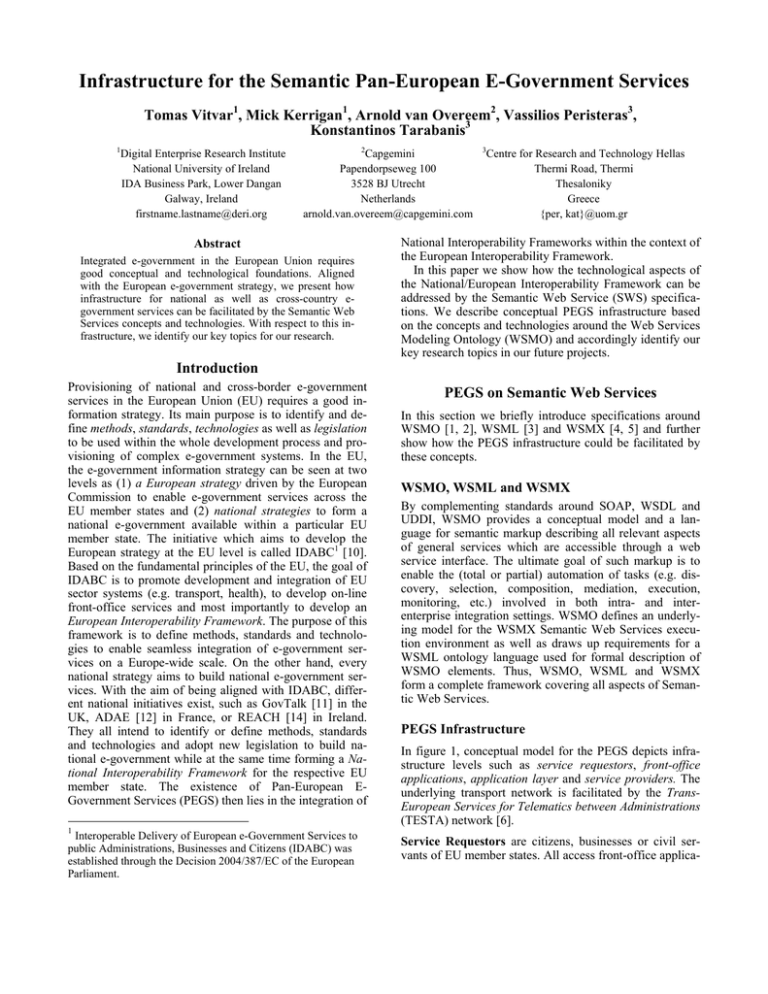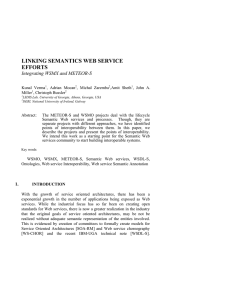Infrastructure for the Semantic Pan-European E-Government Services Tomas Vitvar , Mick Kerrigan
advertisement

Infrastructure for the Semantic Pan-European E-Government Services
Tomas Vitvar1, Mick Kerrigan1, Arnold van Overeem2, Vassilios Peristeras3,
Konstantinos Tarabanis3
1
Digital Enterprise Research Institute
National University of Ireland
IDA Business Park, Lower Dangan
Galway, Ireland
firstname.lastname@deri.org
2
Capgemini
Papendorpseweg 100
3528 BJ Utrecht
Netherlands
arnold.van.overeem@capgemini.com
Abstract
Integrated e-government in the European Union requires
good conceptual and technological foundations. Aligned
with the European e-government strategy, we present how
infrastructure for national as well as cross-country egovernment services can be facilitated by the Semantic Web
Services concepts and technologies. With respect to this infrastructure, we identify our key topics for our research.
3
Centre for Research and Technology Hellas
Thermi Road, Thermi
Thesaloniky
Greece
{per, kat}@uom.gr
National Interoperability Frameworks within the context of
the European Interoperability Framework.
In this paper we show how the technological aspects of
the National/European Interoperability Framework can be
addressed by the Semantic Web Service (SWS) specifications. We describe conceptual PEGS infrastructure based
on the concepts and technologies around the Web Services
Modeling Ontology (WSMO) and accordingly identify our
key research topics in our future projects.
Introduction
Provisioning of national and cross-border e-government
services in the European Union (EU) requires a good information strategy. Its main purpose is to identify and define methods, standards, technologies as well as legislation
to be used within the whole development process and provisioning of complex e-government systems. In the EU,
the e-government information strategy can be seen at two
levels as (1) a European strategy driven by the European
Commission to enable e-government services across the
EU member states and (2) national strategies to form a
national e-government available within a particular EU
member state. The initiative which aims to develop the
European strategy at the EU level is called IDABC1 [10].
Based on the fundamental principles of the EU, the goal of
IDABC is to promote development and integration of EU
sector systems (e.g. transport, health), to develop on-line
front-office services and most importantly to develop an
European Interoperability Framework. The purpose of this
framework is to define methods, standards and technologies to enable seamless integration of e-government services on a Europe-wide scale. On the other hand, every
national strategy aims to build national e-government services. With the aim of being aligned with IDABC, different national initiatives exist, such as GovTalk [11] in the
UK, ADAE [12] in France, or REACH [14] in Ireland.
They all intend to identify or define methods, standards
and technologies and adopt new legislation to build national e-government while at the same time forming a National Interoperability Framework for the respective EU
member state. The existence of Pan-European EGovernment Services (PEGS) then lies in the integration of
PEGS on Semantic Web Services
In this section we briefly introduce specifications around
WSMO [1, 2], WSML [3] and WSMX [4, 5] and further
show how the PEGS infrastructure could be facilitated by
these concepts.
WSMO, WSML and WSMX
By complementing standards around SOAP, WSDL and
UDDI, WSMO provides a conceptual model and a language for semantic markup describing all relevant aspects
of general services which are accessible through a web
service interface. The ultimate goal of such markup is to
enable the (total or partial) automation of tasks (e.g. discovery, selection, composition, mediation, execution,
monitoring, etc.) involved in both intra- and interenterprise integration settings. WSMO defines an underlying model for the WSMX Semantic Web Services execution environment as well as draws up requirements for a
WSML ontology language used for formal description of
WSMO elements. Thus, WSMO, WSML and WSMX
form a complete framework covering all aspects of Semantic Web Services.
PEGS Infrastructure
In figure 1, conceptual model for the PEGS depicts infrastructure levels such as service requestors, front-office
applications, application layer and service providers. The
underlying transport network is facilitated by the TransEuropean Services for Telematics between Administrations
(TESTA) network [6].
1
Interoperable Delivery of European e-Government Services to
public Administrations, Businesses and Citizens (IDABC) was
established through the Decision 2004/387/EC of the European
Parliament.
Service Requestors are citizens, businesses or civil servants of EU member states. All access front-office applica-
Figure 1: Conceptual Semantic PEGS Infrastructure
tions (e.g. Member State and Communal portals) to specify
their needs and inputs.
Front-Office Applications are access points for egovernment services. Typical examples are web portals
(e.g. portal for the Public Administration of the Czech Republic or portal Your Europe) accessible over the Internet.
Apart from providing information, these portals will serve
as access points for service requestors to specify their
needs and requirements against available semantic (panEuropean) e-government services. At this level, transformation of needs to WSML goal and sending the goal to
application layer as well as interactions between service
requestors and application layer are performed.
The Application Layer takes care of the processing of the
WSML goal including interactions with web portals within
the SWS execution process including discovery, composition, mediation and invocation of services. In our approach, the PEGS application layer is built on the WSMX
Execution Environment. Two types of WSMX environment exist in this infrastructure, one at the national level
and one at the communal level. Detail description of
WSMX architecture and its components forming particular
configuration for application layer can be found at [5].
Differences in this configuration may occur based on below mentioned aspects of national or communal environments.
• The National SWS Execution Environment exists
for each member state and takes care of processing
the requests (goals) of member state’s citizens, businesses and civil servants. Based on particular National Interoperability Framework, national interop-
erability standards should be adopted by all public
administrations in the country. Thus we presume that
no mediation is necessary in cases when only national
services are involved in communication (e.g. services
B2 and B3 accessed by user B2 in the figure 1). On
the other hand, national services which are subject to
PEGS must be registered in the communal repositories of the communal SWS execution environment allowing their invocation and mediation within the
cross-country e-government processes (e.g. services
A3 and B1 accessed by user A1 in the figure 1).
• The Communal SWS Execution Environment exists at the EU level. It acts as the Communal Gateway
[9] which facilitates interoperability at (1) the technical level using adapters to adapt different communication protocols and languages, (2) the data/semantic
level using data mediators to resolve semantic mismatches of ontologies and (3) final at the process
level using process mediators to resolve choreography mismatches of services. In addition, in order to
carry out cross-country processes of PEGS, the discovery of SWS’s in a national environment involves
searching for services in the environments own repositories as well as in the communal repositories.
Thus, the communal SWS environment will also provide access to communal services registry of its semantic repository. According to the IDABC specifications, common standards across member states in
terms of data and choreography specifications will
not always exist, therefore the environment of PEGS
will be heterogeneous in nature. The idea is therefore
to develop and maintain domain ontology for PEGS
to eliminate the total possible number of n*(n – 1)
mappings for n ontologies. This will require the
Communal Gateway to resolve semantic and choreography mismatches and maintain all mappings centrally.
Service Providers are member state administrations
whose services are registered with the WSMX environment. In order to use these services in WSMX, they must
be semantically described using WSML and must use the
SOAP protocol for communication. For this purpose, specific adapters are developed and used.
Conclusion and Future Work
Our research in semantic e-government is in the early
stages. Information presented in this paper is reflecting our
initial conceptual model for the Semantic PEGS infrastructure based on the recent IDABC specifications and the
Semantic Web Service technologies. In our future research, we plan to apply, align and improve the SWS technologies based on requirements from e-government.
Our future research lies in various aspects of National/European Interoperability Frameworks based on the
WSMO conceptual model and WSMX execution environment. Our future research topics will include:
• Integration of access portals with Semantic Web
Services. Aligned with efforts in ontology-enabled
web portals (e.g. SEAL[8], SPORTS[7]) our aim is to
address goal presentation and goal specification to
users, support for semi-automated and contextawareness selection of services based on service requestor’s behavior and profile, etc.
• Definition of service model for Public Administrations based on WSMO conceptual model. General
service model according to WSMO specifications
needs to be verified according to certain requirements
from Public Administration (PA) domain. For example, PA domain defines concepts such as Service
Consequence [13] with slightly different definition
from WSMO Service Interface (choreography and
orchestration). The research goal will be to provide
WSMO service model for PA domain.
• Definition, alignment and development of WSMX
architecture. WSMX architecture and its components will be developed based on PA Service Model
and requirements from e-government scenarios. This
will include advance enhancements of WSMX architecture towards peer-to-peer networks, distributed
service discovery and composition, etc.
• Definition of PA domain ontology. The research
goal is to propose reusable, top-level ontology for the
overall PA domain. Such domain ontology is important in order to exploit full range of the Semantic
Web Services and reduce heterogeneity of services.
We will base our research on the domain modeling
principles for modeling complex organization systems as well as PA theory. Implementation of PA
domain ontology in WSML language will be provided.
• New business models for national and PEGS provision. In order to manage the volume and diversity
of social needs and at the same time avoid fragmentation, dissolution and a legitimacy deficit, PA systems
need to be reengineered. A paradigm shift of today’s
modus operandi will be introduced, coupled by new
business models in order to facilitate the necessary
PA internal and external systemic adjustment. Specifically, PA systems should develop to achieve (1)
internal integration at the administrative intra- and inter- agency level, and (2) external integration with
society. To this direction, we intend to use SWS architectures, models and technologies to facilitate PA
integration in both levels.
Acknowledgment: This paper and works upon which this
paper is based is supported by the Science Foundation Ireland under Grant No. 02/CE1/I131, and European projects
SemanticGov (FP6-2004-IST-4-027517) and KnowledgeWeb (FP6-507482).
References
1. D. Roman, U. Keller, H. Lausen, J. Bruijn, R. Lara, M. Stollberg, A. Polleres, C. Feier, C. Bussler, D. Fensel: Web Service Modeling Ontology, Applied Ontology 1 (1), IOS Press
2005.
2. D. Roman et al.: Web Service Modeling Ontology v1.2,
WSMO Final Draft, http://www.wsmo.org/TR/d2/v1.2/.
3. H. Lausen, J. Bruijn, D. Fensel: WSML – a Language
Framework for Semantic Web Services, Rule Languages for
Interoperability, 2005.
4. M. Moran, M. Zaremba, A. Mocan, C. Bussler: Using
WSMX to bind Requester & Provider at Runtime when Executing Semantic Web Services, 1st WSMO Implementation
Workshop, Sep, 2004, Frankfurt, Germany.
5. M. Zaremba, M. Moran, WSMX Architecture, WSMX
Working Draft, http://www.wsmo.org/TR/d13/d13.4/v0.3/.
6. TESTA: Trans European Services for Telematics between
Administrations,
http://europa.eu.int/idabc/en/document/2097/5644.
7. Jian Zhou, Yong Yu, Chenxi Lin, Lei Zhang, Yin Yang,
Integrating Web Services into Ontology-based Web Portal.
In Proc. of the Seventh Asia Pacific Web Conference (APWeb) March 29 - April 1, 2005, Shanghai, China.
8. Maedche, A., Staab, S., Stojanovic, N., Studer, R., Sure, Y.:
SEAL – a framework for developing semantic web portals.
In: Proceedings of the 18th British National Conference on
Databases. Volume 2097 of LNCS. (2001) 1–22.
9. A. Overeem, J. Witters, Architecture for Delivering panEuropean e-Government Services, IDA technical report,
Capgemini 2004.
10. Interoperable Delivery of European e-Government Services
to public Administrations, Businesses and Citizens (IDABC),
http://europa.eu.int/idabc/.
11. GovTalk, http://www.govtalk.gov.uk/.
12. ADAE, http://www.adae.asso.fr/.
13. Vassilios Peristeras, Konstantinos A. Tarabanis: The Governance Enterprise Architecture (GEA) High-Level Object
Model. KMGov 2004: 101-110.
14. REACH, http://www.reach.ie/.







